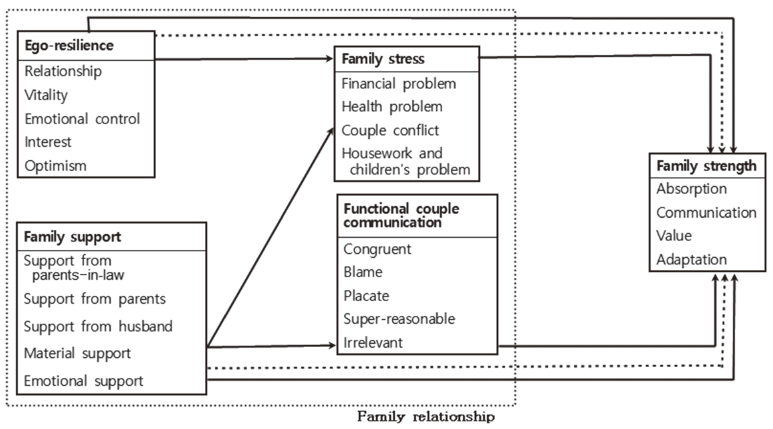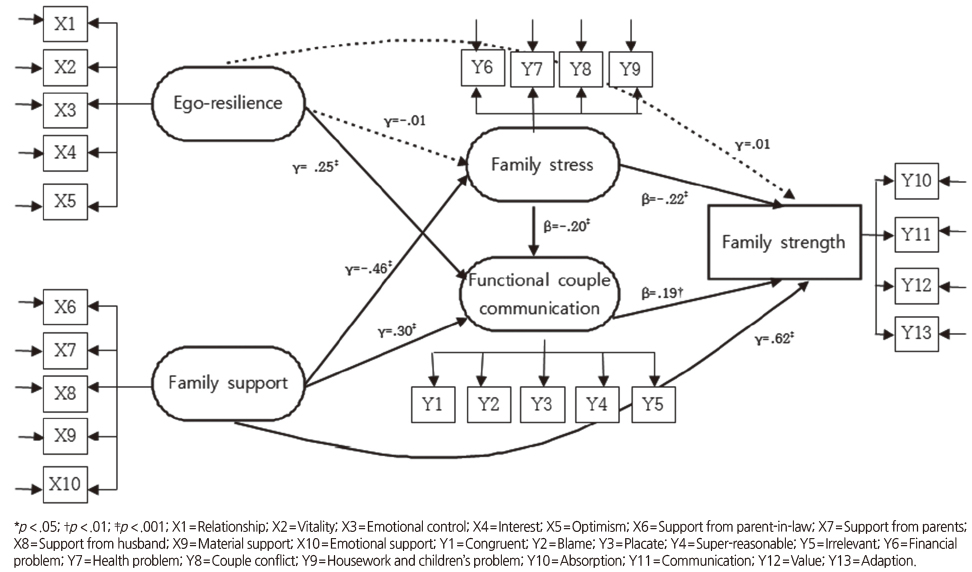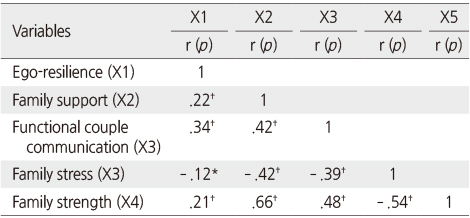Articles
- Page Path
- HOME > J Korean Acad Nurs > Volume 45(6); 2015 > Article
-
Original Article
- A Structural Equation Model on Family Strength of Married Working Women
- Yeong Seon Hong, Kuem Sun Han
-
Journal of Korean Academy of Nursing 2015;45(6):900-909.
DOI: https://doi.org/10.4040/jkan.2015.45.6.900
Published online: December 31, 2015
1Research Institute of Clinical Medicine, Dankook University Hospital, Cheonan, Korea.
2College of Nursing, Korea University, Seoul, Korea.
- Address reprint requests to: Han, Kuem Sun. College of Nursing, Korea University, 145 Anam-ro, Seongbuk-gu, Seoul 02841, Korea. Tel: +82-2-3290-4910, Fax: +82-2-928-9107, hksun@korea.ac.kr
© 2015 Korean Society of Nursing Science
This is an Open Access article distributed under the terms of the Creative Commons Attribution NoDerivs License. (http://creativecommons.org/licenses/by-nd/4.0/) If the original work is properly cited and retained without any modification or reproduction, it can be used and re-distributed in any format and medium.
Abstract
-
Purpose
- The purpose of this study was to identify the effect of predictive factors related to family strength and develop a structural equation model that explains family strength among married working women.
-
Methods
- A hypothesized model was developed based on literature reviews and predictors of family strength by Yoo. This constructed model was built of an eight pathway form. Two exogenous variables included in this model were ego-resilience and family support. Three endogenous variables included in this model were functional couple communication, family stress and family strength. Data were collected using a self-report questionnaire from 319 married working women who were 30~40 of age and lived in cities of Chungnam province in Korea. Data were analyzed with PASW/WIN 18.0 and AMOS 18.0 programs.
-
Results
- Family support had a positive direct, indirect and total effect on family strength. Family stress had a negative direct, indirect and total effect on family strength. Functional couple communication had a positive direct and total effect on family strength. These predictive variables of family strength explained 61.8% of model.
-
Conclusion
- The results of the study show a structural equation model for family strength of married working women and that predicting factors for family strength are family support, family stress, and functional couple communication. To improve family strength of married working women, the results of this study suggest nursing access and mediative programs to improve family support and functional couple communication, and reduce family stress.
This manuscript is manuscript is a revision of the first author's master's thesis from Korea University.
The authors declared no conflict of interest.
- 1. Nam SD. The prediction model of mid-life women's family stress and mental health: Focused on perfectionism, self-acceptance and social support [dissertation]. Seoul, Chung Ang University. 2009.
- 2. Kim KW, Doh HS, Kim S, Rhee SH. The relationship between maternal employment, maternal job characteristics, spousal support, and parenting stress. Korean J Child Stud. 2010;31(5):101–113.
- 3. Aryee S, Srinivas ES, Tan HH. Rhythms of life: Antecedents and outcomes of work-family balance in employed parents. J Appl Psychol. 2005;90(1):132–146. ArticlePubMed
- 4. Kirchmeyer C. The different effect of family on objective career success across gender: A test of alternative explanations. J Vocat Behav. 2006;68(2):323–346.
- 5. Song DY, Jang SJ, Kim EJ. An analysis of factors affecting work-family conflict of Korean working people: Focusing the effect of workplace support and familial support. Soc Welf Policy. 2010;37(3):27–52.Article
- 6. Statistics Korea. Economically active population survey [Internet]. Daejeon, Author. 2008;cited 2015 January 1. Available from: http://www.index.go.kr/potal/main/EachDtlPageDetail.do?idx_cd=1572
- 7. Grice MM, Feda D, McGovern P, Alexander BH, McCaffrey D, Ukestad L. Giving birth and returning to work: The impact of work-family conflict on women's health after childbirth. Ann Epidemiol. 2007;17(10):791–798. ArticlePubMed
- 8. Marshall NL, Tracy AJ. After the baby: Work-family conflict and working mothers' psychological health. Fam Relat. 2009;58(4):380–391. Article
- 9. Lee SM, Kim KS. The effect of family stress and family strengths on depression of married people. J Fam Relat. 2012;17(3):3–22.
- 10. Yoo YJ. A study on the development of Korean family strengths scale for strengthening the family. J Fam Relat. 2004;9(2):119–151.
- 11. Olson DH, DeFrain J. Marriage and the family: Intimacy, diversity and strengths. 3rd ed. Mountain View, CA: Mayfied; 2003.
- 12. Koo MR, Song JA. A case study of the family art therapy on the enhancement of family communication and health of family relationship. Korean Art Ther Assoc. 2010;17(2):443–472.Article
- 13. Ledermann T, Bodenmann G, Rudaz M, Bradbury TN. Stress, communication, and marital quality in couples. Fam Relat. 2010;59(2):195–206. Article
- 14. Voydanoff P. Toward a conceptualization of perceived work-family fit and balance: A demands and resources approach. J Marriage Fam. 2005;67(4):822–836. Article
- 15. Brooks RB. The power of parenting. In: Goldstein S, Brooks RB, editors. Handbook of resilience in children. New York, NY: Springer; 2006. p. 297–314.
- 16. Laliberte S, Bohn U, Bartlett KR, West C, Englehart R. Families and family nursing. J Fam Nurs. 2002;8(1):3–10. ArticlePDF
- 17. Lim SC, Rhee CW. Parent-child communication and self-management of adolescents with type 1 diabetes: The mediating effect of diabetes-related family support. Korean J Fam Soc Work. 2011;32(6):235–260.
- 18. Block J, Kremen AM. IQ and ego-resiliency: Conceptual and empirical connections and separateness. J Pers Soc Psychol. 1996;70(2):349–361.ArticlePubMed
- 19. Yoo SK, Shim HW. Psychological protective factors in resilient adolescents in Korea. Korean J Educ Psychol. 2002;16(4):189–206.Article
- 20. King LA, Mattimore LK, King DW, Adams GA. Family support inventory for workers: A new measure of perceived social support from family members. J Organ Behav. 2006;16(3):235–258. Article
- 21. Yoon OH. A study on subjective quality of life of married working women: Focused on structural relations between effecting factors [dissertation]. Namwon, Seonam University. 2009.
- 22. McCubbin HI, Patterson JM, Wilson L. Family inventory of life events and changes. St. Paul, MN: University of Minnesota; 1979.
- 23. Satir VM. A partial portrait of a family therapist in process. In: Fishman HC, Roseman BL, editors. Evolving models for family change: A volume in honor of Salvador Minuchin. New York, NY: Guilford Press; 1986. p. 278–193.
- 24. Park MY. Effects of role strain and parenting stress of married nurses on communication coping style and psychological well-being [master's thesis]. Seoul, Korea University. 2012.
- 25. Eo EJ, Yoo YJ. A study on development of the scale for measuring family strengths. J Korean Home Manage Assoc. 1995;13(1):145–156.
- 26. Ha OR, Kwon JH. Mental health and role satisfaction of working mothers: Role conflict, perfectionism, and family/spouse support. Korean J Clin Psychol. 2006;25(3):675–696.
- 27. Kim H, Ha C. A study on determinants of psychological and social adjustment in adolescents from remarried families. Korean J Youth Stud. 2010;17(4):67–101.
- 28. Kim EJ, Hwang KR, Kwun YU. Relationship among spouse's psychological type, self-esteem, and communication. Korean J East West Mind Sci. 2007;10(1):15–26.
- 29. Lee EH. Study on the adaptation of married immigrant women to family stress: Application of the resiliency model. Korean J Fam Welf. 2009;14(1):73–94.
- 30. Chang YS, Park YS. The relationship among children's perceived parent-child communication, ego-resilience and conflict resolution strategies in children's friendship. Korean J Stress Res. 2008;16(3):271–280.
REFERENCES
Figure & Data
REFERENCES
Citations

- Effects of family beliefs and family strength on individual resilience and quality of life among young breast cancer survivors: A cross‐sectional study
Lin Tao, Xiaoxia Hu, Lan Fu, Xiaoxia Zhang, Hong Chen
Journal of Clinical Nursing.2023; 32(11-12): 2616. CrossRef - Factors influencing quality of life in caregivers of adolescents with developmental disabilities
Joung Woo Joung
Osong Public Health and Research Perspectives.2022; 13(4): 298. CrossRef - Developing a Prediction Model for Family Health in Families of Patients with Schizophrenia
Kuem Sun Han, Yeong Seon Hong, Hyuncheol Kang, Youn Hee Roh, Myung Sook Choi, Hee Jin Moon
Journal of Korean Academy of Psychiatric and Mental Health Nursing.2019; 28(4): 309. CrossRef


Figure 1
Figure 2
Correlation among Major Variables
*p<.05; †p<.001.
Comparison of Model Fit of Modified Model to Hypothetical Model
GFI=Goodness-of-fit index; CFI=Comparative fit index; NFI=Normed fit index; TLI=Tucker-Lewis index; RMSEA=Root means-square error of approximation; AIC=Akaike information criterion.
Standardized Direct, Indirect, and Total Effects for the Final Model
*p<.05; †p<.01; ‡p<.001; SMC=Squared multiple correlations.
*
GFI=Goodness-of-fit index; CFI=Comparative fit index; NFI=Normed fit index; TLI=Tucker-Lewis index; RMSEA=Root means-square error of approximation; AIC=Akaike information criterion.
*
 KSNS
KSNS
 E-SUBMISSION
E-SUBMISSION





 Cite
Cite

